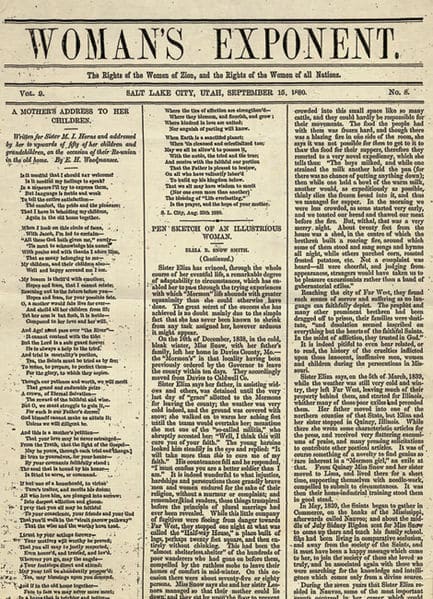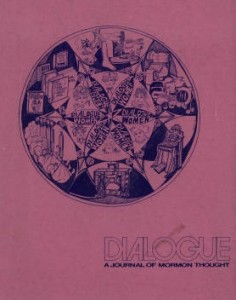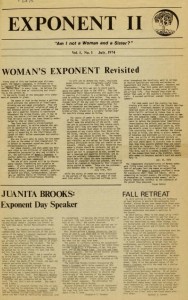 Sherrie (Spunky) invited me to write a blog about motherhood and birthing for her series. When I asked what she had in mind, she suggested something about the birth of Exponent II, the remarkable journal now celebrating its fortieth anniversary.
Sherrie (Spunky) invited me to write a blog about motherhood and birthing for her series. When I asked what she had in mind, she suggested something about the birth of Exponent II, the remarkable journal now celebrating its fortieth anniversary.
People over the years have asked why our little coven of LDS feminists in Boston was invited to edit a volume of Dialogue and why we felt called, worthy, able to write a book and begin a newspaper. Surely we must have had some secret license, some mystical call. Otherwise, how did we have the nerve to set ourselves up like that.
I love those questions which accord us an authority we never had and a position of some importance. Nobody asked us. Nobody invited us. Nobody really encouraged us. We just did things. We didt worry about permission from the far off Rockies. We thought we were pretty much invisible out there by Plymouth Rock. We originally met to talk about our lives as Mormon women. We were church members, mostly wives of students or young professionals. It was a time when women were rising, expressing some discontents, and we certainly had some, although I think those issues would seem pretty tame today. Mostly, though, we just wanted to talk, to share our ideas and our grievances. Much sturm and drang attended those sessions and many anxious tears were shed.
It seemed to me that it was time for us to do something rather than just talk. Some of the group had already been involved in the highly successful guidebook A Beginners’ Boston where they had demonstrated their organizational and creative abilities. That was before my time, but the evidence was there: they had taken on a big project and pulled it off. The guidebook would not likely have happened without Bishop Bert Van Uitert’s idea for a fund raiser (which was dismissed by the Harvard Business School students as too much work), Bonnie Horne’s position as president of the Relief Society and her organizing skills, Laurel Ulrich’s literary skills, Carolyn Person’s artistic skills, and the willingness of many of the sisters to take on research projects. As much as anything the guide book worked because the group was all Mormon and used to cooperating and working together.
I thought that we should use that model because it was so fruitful and satisfying. We all had skills of one kind or another. We had clever and interesting people of many stripes. Because of our legendary cooks and hostesses, we launched impressive social events. We undertook to do an annual dinner, inviting in some distant distinguished guest speaker. We sold tickets to defray the costs. We started early to organize retreats where the administrative talents of some were utilized for weekend gatherings. We were open for all projects and activities suggested.
I thought we might guest-edit a women’s issue of Dialogue and suggested the idea to Eugene England, the https://exponentii.org/wp-content/uploads/2021/12/IMG_5173-scaled-2.jpg, when he was visiting. He took us up immediately and we worked on that, generating ideas, discussing submissions, brainstorming writers we would like to include. That was a real life-changer for me because I was required to write and edit, something I had never done before. That was our style. We did everything that came to mind and to hand.
We were originally concerned only about our own lives and problems, but in the next phase we moved to the past. This happened for several reasons. One was that Susan Kohler discovered the bound volumes of the Woman’s Exponent in Harvard’s Widener Library. This semi-official Mormon journal (1872-1914) was well known to people in the Mormon history business, but not to us. We checked out those volumes and mined them for much wonderful stuff. The second 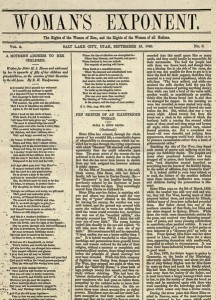 reason was that we were told that our issue of Dialogue, which dealt very well with lots of contemporary issues, did not address the “real Mormon women’s issues” which were patriarchy and polygamy. They were certainly historical Mormon issues, but they were not our issues. Maybe they should be. It was at this point that we took on the teaching of an LDS Institute class which I insisted on calling, “Roots and Fruits of Mormon Women.” No one liked this title but me. I thought that the then ubiquitous “Roots and Wings” title was impossibly pretentious and sentimental. Besides, weren’t we all fruits? I often thought so. These class presentations were then turned into essays which eventually became Mormon Sisters: Women in Early Utah. Writing that book was really hard. People who had never done so before did research and wrote papers; we created a manuscript and after having it turned down, in another of our great innovations, we founded a press, borrowed money from a bank, and published our own book. All that took a long time, but again, we worked together. And we worked well together. We did the things we could and acquired new skills. Carrell Sheldon carried us along a lot of that way.
reason was that we were told that our issue of Dialogue, which dealt very well with lots of contemporary issues, did not address the “real Mormon women’s issues” which were patriarchy and polygamy. They were certainly historical Mormon issues, but they were not our issues. Maybe they should be. It was at this point that we took on the teaching of an LDS Institute class which I insisted on calling, “Roots and Fruits of Mormon Women.” No one liked this title but me. I thought that the then ubiquitous “Roots and Wings” title was impossibly pretentious and sentimental. Besides, weren’t we all fruits? I often thought so. These class presentations were then turned into essays which eventually became Mormon Sisters: Women in Early Utah. Writing that book was really hard. People who had never done so before did research and wrote papers; we created a manuscript and after having it turned down, in another of our great innovations, we founded a press, borrowed money from a bank, and published our own book. All that took a long time, but again, we worked together. And we worked well together. We did the things we could and acquired new skills. Carrell Sheldon carried us along a lot of that way.
One evening as I came home from a meeting I noted to my husband that we could do anything. That everything we turned our hands to succeeded. That I couldn’t even think of anything else for us to try. He said that we might consider starting a newspaper. That good idea built upon several of our earlier successes. The 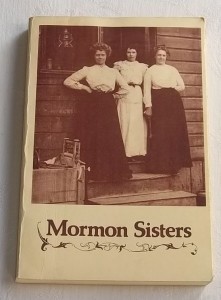 group was enthusiastic. We even had a person with newspaper experience who could take on the https://exponentii.org/wp-content/uploads/2021/12/IMG_5173-scaled-2.jpgship. But she was also the president of the Relief Society and a new mother. The bishop refused to release her from the Relief Society when she asked, so she turned down the https://exponentii.org/wp-content/uploads/2021/12/IMG_5173-scaled-2.jpgship. When this was reported in one of our meetings, Carrell Sheldon turned to me and said, “Well, you’ll just have to do it.” And that is how I became the https://exponentii.org/wp-content/uploads/2021/12/IMG_5173-scaled-2.jpg of Exponent II.
group was enthusiastic. We even had a person with newspaper experience who could take on the https://exponentii.org/wp-content/uploads/2021/12/IMG_5173-scaled-2.jpgship. But she was also the president of the Relief Society and a new mother. The bishop refused to release her from the Relief Society when she asked, so she turned down the https://exponentii.org/wp-content/uploads/2021/12/IMG_5173-scaled-2.jpgship. When this was reported in one of our meetings, Carrell Sheldon turned to me and said, “Well, you’ll just have to do it.” And that is how I became the https://exponentii.org/wp-content/uploads/2021/12/IMG_5173-scaled-2.jpg of Exponent II.
We began the paper without an agenda, although in the first issue I said that we wrote from the “twin pedestals of Mormonism and feminism” and that we aimed to show that they were compatible “by our words and by our lives.” We were not out to wreak change; we wrote the paper for ourselves. The best description of what we were trying to do was Laurel’s. She said that it was like “a long letter from a dear friend.” I did not foresee that what we were doing would be offensive, and the worst that cautioning officials could come up with was that while it was OK now, it might well turn into Something Else.
I like this model of women’s activism, that we come up with an idea—preferably one of our own rather than something from on high—and that we work together to make it happen. This is the garden of a million blooming flowers. I like that better than the David against Goliath model. The scrappy little guy generally doesn’t win. And if fighting is required, I favor running away when the battle gets tough, remaining to fight another day. But there is plenty of room for many, many good plants to blossom.
I would also say, after my long years of labor in the projects, that the best are those with a written legacy. Words are what really last. The meals and the events recede. The writing is what remains. So I think it is important to aim for written projects. And I still like paper in bound books for lasting purposes. I may yet come to feel that documents stored in the clouds have the best chance for survival and influence, but for now I would still rather have a book on a shelf.
That Exponent II and its various later incarnations is still alive today is strong evidence for the power of women to conceive ideas and carry them on. What was once a small suggestion has amassed an impressive publishing record, serious archives, a long list of participants and alumni, and a powerful presence in the lives of many women. Exponent II is now forty years old, certainly poised to outlive her mother and model, the Women’s Exponent, published for forty two years. Life spans have increased since the nineteenth century and forty is not very old now. I hope the paper will still be around for many years to come.


